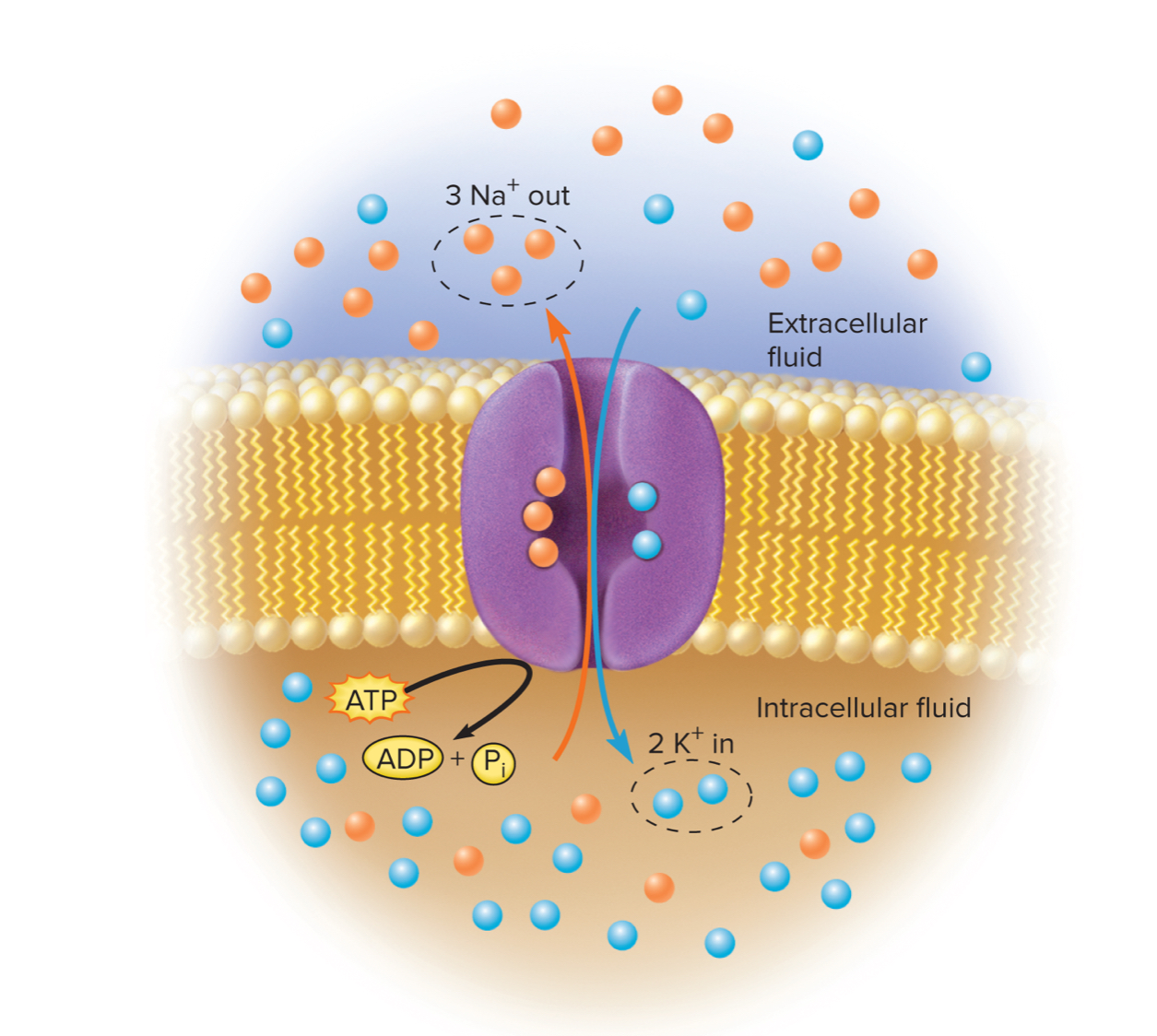anatomy and physiology ch. 3 cells
1/140
There's no tags or description
Looks like no tags are added yet.
Name | Mastery | Learn | Test | Matching | Spaced |
|---|
No study sessions yet.
141 Terms
Cytology
the scientific study of cells
Born in 1663 by Robert Hooke when observing empty cell walls of cork
Cell theory
especially credited by Theodore Schwann and Matthias Schleiden
Most essential points of the cell theory
all living organisms are made of one or more.
Basic structural and functional units of all living organisms.
All activities of an organism stem from the activities of its cells.
All cells arise from preexisting cells and pass hereditary information
Squamous
Thin, flat cell, often have a bulge where the nucleus is (like a fried egg, "sunny side up")
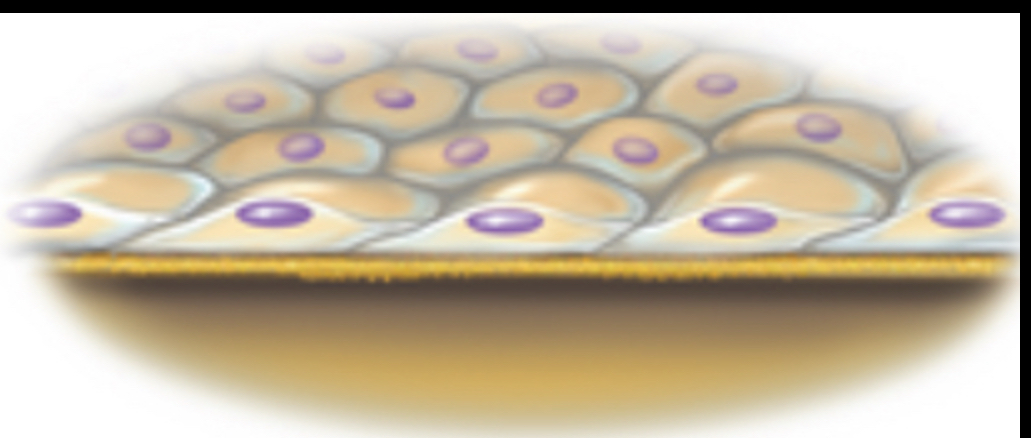
Cubodial
Squarish cells and approx. as tall as they are wide (liver cells)
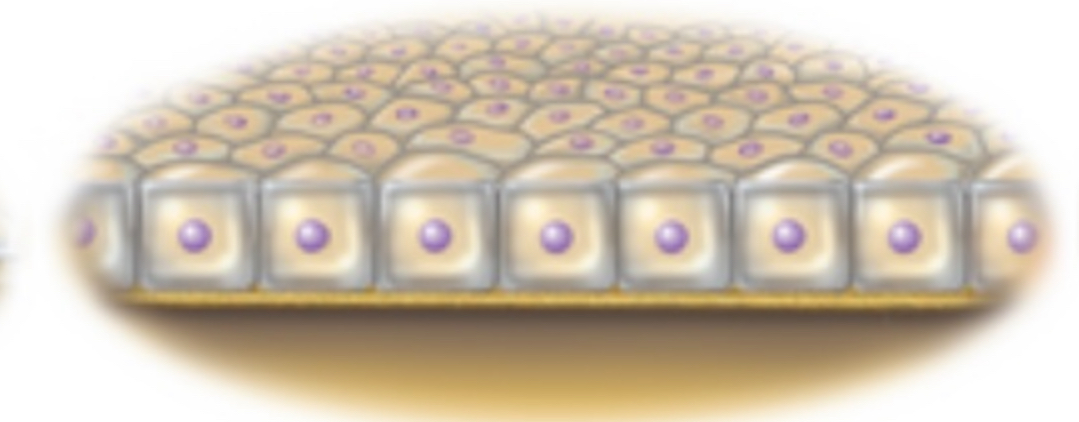
Columnar
Cells taller than they are wide (intestine lining)

Polygonal
cells with irregularly angular shapes and with four, five, or more sides.
Like wax cells of a honeycomb
Densely packed cells in many glands
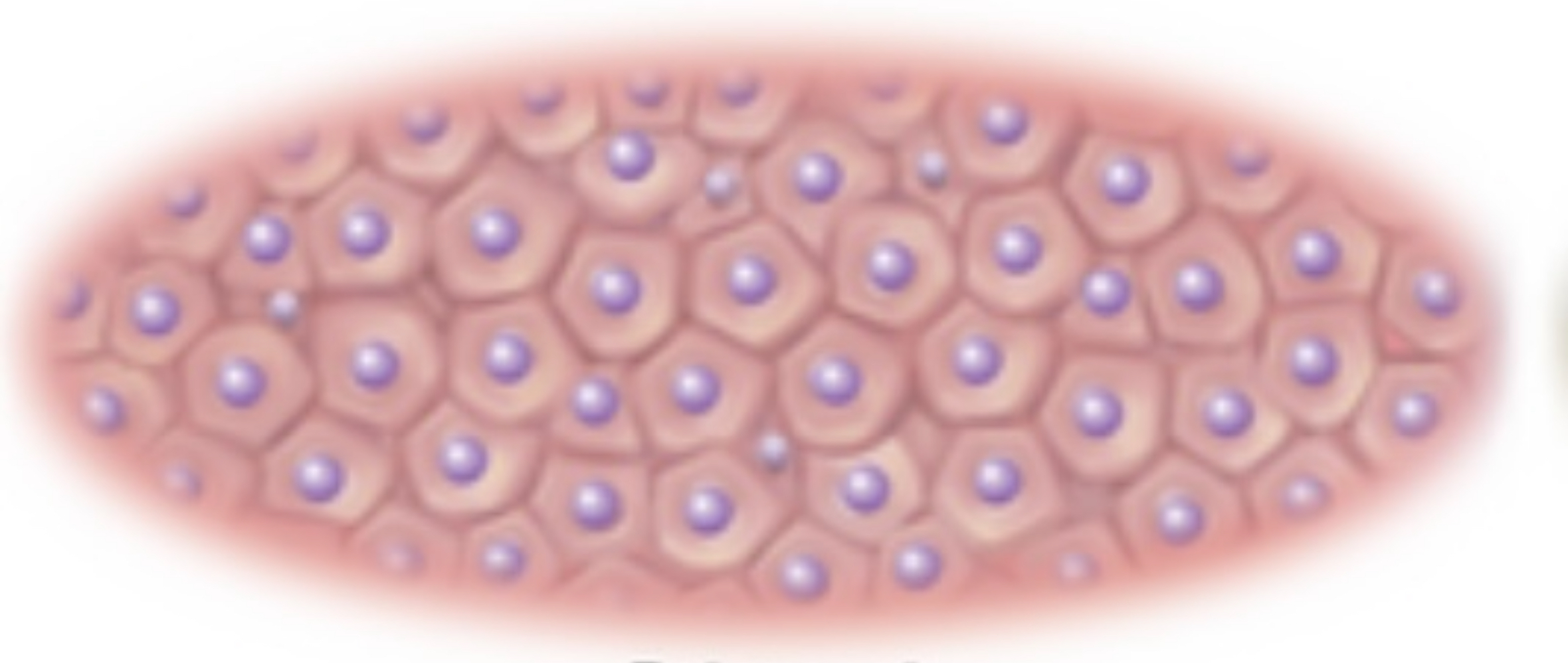
Stellate
Starlike cell shape (nerve cells)
Cell bodies of many nerves are stellate.
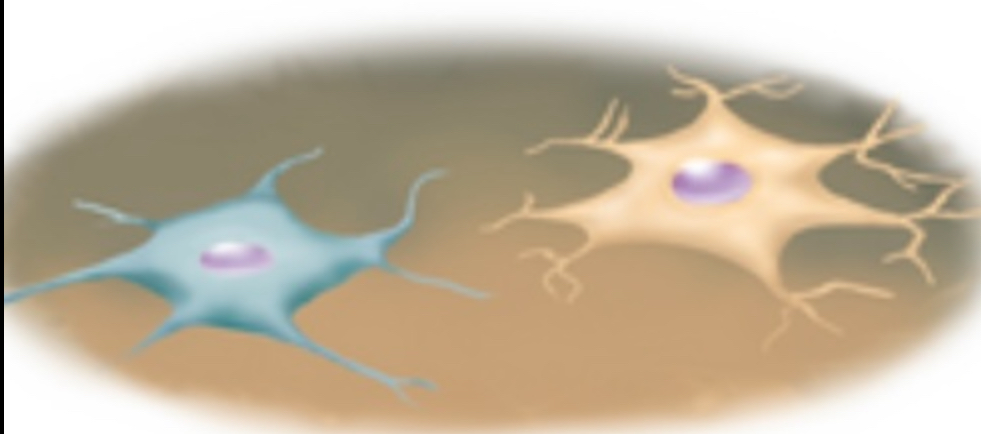
Spheroid to ovoid
Spherically shaped cells
In egg cells and white blood cells
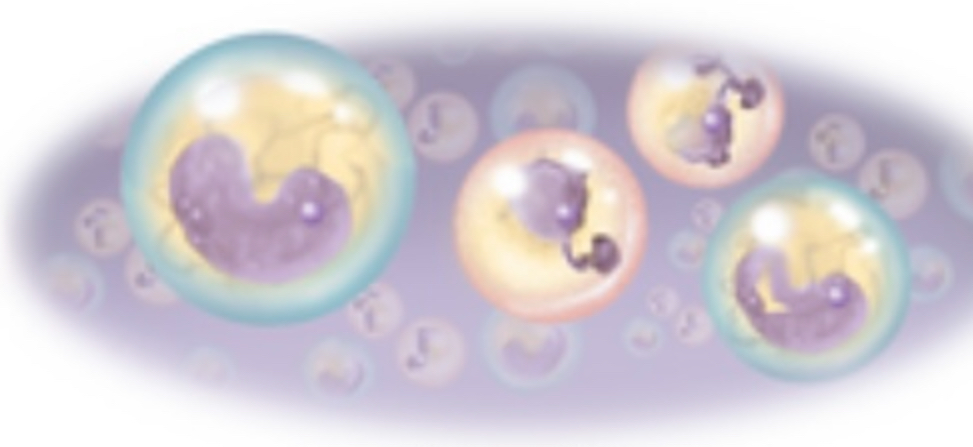
Discoid
disc shaped cells
(red blood cells)

Fusiform
Spindle shaped, elongated
thick in the middle and tapered toward the end
In smooth muscle cells
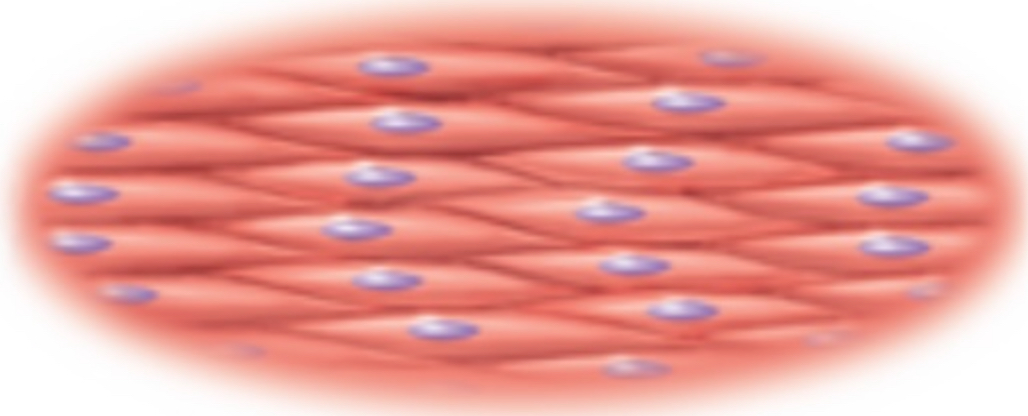
Fibrous
Long, slender
threadlike cells
In skeletal muscle cells an the axons of nerve cells
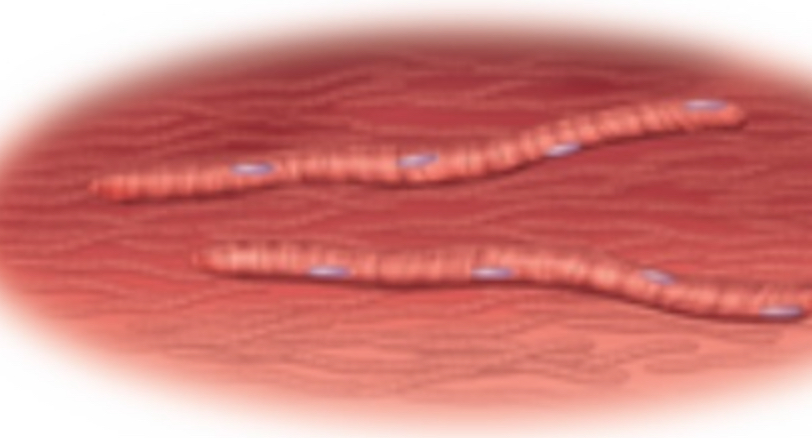
Why do some cell shapes look different?
Does not capture the 3-D shape of the cell
Some cell shapes can look like others if viewed from its upper surface.
Micrometer (µm)
The most useful unit of measure for designating cell sizes
The smallest objects most people can see with the naked eye are about 100 µm
How big (in micrometers) are most human cells
10 to 15 micrometers wide
How long are the longest human cells
Nerve cells are sometimes over a meter long
Muscle cells are up to 30 cm long
Both are too slender to be seen with the naked eye.
Why can't cells grow to unlimited size
if cells swelled to an excessive size, it could rupture like an overfilled water balloon.
Limited between its volume and surface area.
A cell that is too big cannot support itself.
Molecules could not diffused from place to place fast enough to support its metabolism.
The death of one or a few cells has less effect on structure and function of the whole organ.
Cytoplasm
the gel like fluid between the nucleus and surface membrane, contains cytoskeleton, organelles, inclusions
The clear structureless gel in a cell is its
Cytosol
The Na+-K+ pump is
A transmembrane protein
What process can only occur in the plasma membrane
Active transport
Membrane carriers resemble enzymes except the fact that carriers
Do not chemically change their ligands
Most cellular membranes are made by
The ER
When a hormone cannot enter a cell it activates a
Second messenger
The force exerted on a membrane by water is called
Hydrostatic pressure
Two granular organelles that synthesize and degrade proteins
Ribosomes, proteasomes
Liver cells detoxify alcohol w the two organelles
Smooth ER and peroxisomes
The space enclosed by the membranes of the Golgi and ER is called the
Cistern
TEM: Transmission Electron Microscope
reveals more detail than the light microscope. (LM)
uses a beam of electrons in place of light. Assisted in seeing the cells ultrastructure.
SEM: Scanning electron microscope
3-D images at high magnification and resolution can only view surface features
Vascular corrosion cast technique
The vessels are drained and flushed with saline, then carefully filled with a resin.
After resin solidifies the actual tissue is dissolved w corrosive agent
This leaves only a resin cast of the vessels
Plasma (cell) membrane
made up of proteins and lipids
Composition and functions differ significantly from one region of a cell to another, especially the basal, lateral and apical surfaces of cells
Cytoskeleton
a supportive framework of protein filaments and tubules, an abundance of organelles, and inclusions.
Cytosol or intracellular fluid (ICF)
a clear fluid that the organelles and cytoskeleton are embedded in
Extracellular Fluid
all body fluids not contained in the cells
fluid outside of the cell
located amid cells is also called tissue (interstitial) fluid.
Some fluids include blood plasma, lymph, or cerebrospinal fluid.
The plasma membrane
Defines boundaries of the cell
Governs its interactions with other cells
Controls the passage of materials into and out of the cell.
Intracellular face
The side that faces the cytoplasm (inside)
Extracellular face
The side that faces outward the cytoplasm (outside)
What percentage of membrane molecules are lipids and how many of those are phospholipids?
98%, 75%
What percentage of cholesterol molecules constitute the membrane lipids
20%
What membrane lipids make up the last 5% of the membrane lipids
Glycolipids
Glycolipids
phospholipids with short carbohydrate chains on the Extracellular face of the molecule.
carbohydrates help form the glycocalyx (a carb coating with multiple functions)
Transmembrane Proteins
pass completely though the phospholipid bilayer protruding on both sides.
Have hydrophilic regions in contact with the water
Have hydrophobic regions that pass back and forth through the lipid.
Most of these are glycoproteins
Peripheral proteins
do not protrude into the phospholipid layer but rather adhere to one face of the membrane
often times anchored to a transmembrane protein and tethered to the cytoskeleton
Function of membrane proteins: Receptors
Surface proteins usually specific for a particular messenger that allows for said messenger to communicate with the cell
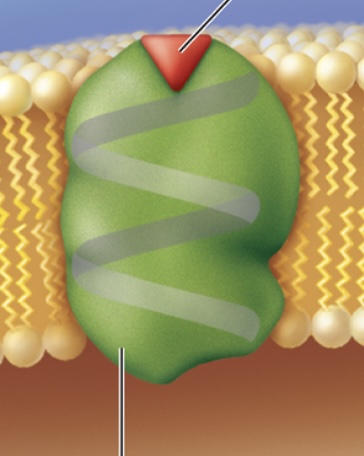
Functions of membrane proteins: enzymes
carry out the final stages of starch and protein digestion
Help produce second messengers
Break down hormones and other molecules whose job it done.

Functions of membrane proteins: channel proteins
passages that allow water and hydrophilic solutes to move through membrane.
Leak channels are always open and allow materials to pass continually.

Gates (gated channels)
open and close under different circumstances and allow solute thru sometimes but not others
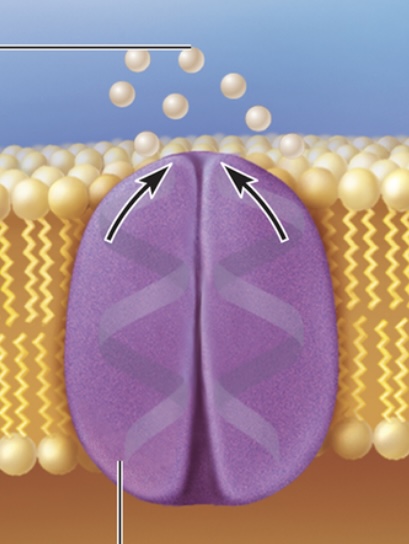
Three types of stimuli that would open gates
1) Ligand respond to chemical messengers
2) Voltage respond to changes in voltage of plasma membrane
3) mechanically respond to physical stress on a cell such as stress and pressure.
These channels play an important role in the timing of nerve signals and muscle contractions.
Functions of membrane protiens: carriers
Are transmembrane proteins that bind to glucose, electrolyte and other solutes and transfer them to the other side of the membrane.
Pumps consume ATP in the process.
Functions of membrane proteins: cell-identity markers
acts like an “identification tag” that enables the immune system to tell which cells belong to the body and which are foreign invaders.
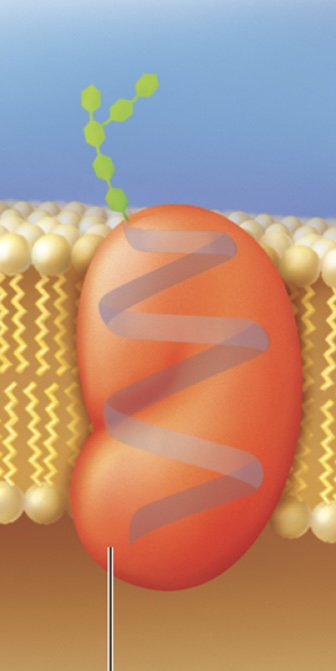
Functions of membrane proteins: cell-adhesion molecules (CAMs)
cells adhere to one another and extracellular materials through membrane proteins
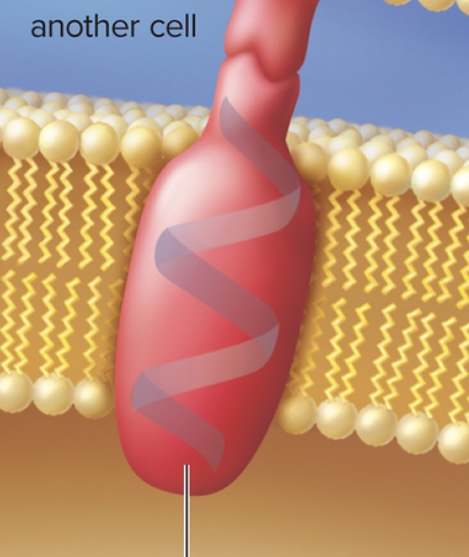
Calcium Channel Blockers
a class of drugs
Changes of the gated membrane channels strongly influence blood pressure.
This type of drug prevents channels from opening and relax the arteries, increase blood flow, relieve angina and lower BP.
G protein
named from the ATP-like chemical GTP
Relays the signal to another membrane protein adenylate cyclase
Triggers physiological changes within the cell
Up to 60% of drugs work by altering the activity of these proteins
Adenylate cyclase (enzyme in membrane)
When the G protein is activated by the receptor it relays it to ____ _____ which removes two phosphate groups from ATP and converts it to cyclic AMP (cAMP)
Cyclic AMP
a second messenger, activates enzymes called Kinases in the cytosol
Kinase
activated by cAMP, add phosphate groups to other cellular enzymes
Glycocalyx: definition/composition
A fuzzy coating of the cell that acts as an ID tag.
enables the body to distinguish its own healthy tissues from transplanted tissues, invading organisms and diseased cells.
- gives us our blood type.
Glycocalyx: Functions
1) Protection- cushions and protects membrane from chemical and physical injury
2.) immunity to infection- enables the immune system to recognize and selectively attack foreign organisms
3.) Defense against Cancer - recognize and destroy
4. ) transplant compatibility- forms the basis for compatibility of blood transfusions, tissue grafts, organ transplants
5) cell adhesion- binds cells together so tissue don’t fall apart
6. Fertilization - sperm recognize & bind to eggs
7. Embryonic development - guides embryonic cells to destinations
Microvilli
extensions of the plasma membrane that serve primarily to increase a cell's surface area
best developed in cells specialized in absorption.
Give cells 15 to 40 times as much absorptive surface area
Cells like taste buds and inside ear serve more for sensory (tiny bumps)
Actin
Protein that attach to the inside of the plasma membrane at the tip of the microvillus, anchor the microvillus to the terminal web.
Cilia (nonmotile)
hairlike processes about 7 to 10 micrometers long
Nearly every human cell has a single nonmotile primary cilium
Serve as the cells antenna for monitoring nearby conditions.
Ex: in the ear, they play a role in the sense of balance
Defects in the development, structure or functions of this are sometimes responsible for birth defects and hereditary diseases
Motile cilia
less widespread but more numerous on cells that have them
Occur in the respiratory tract, uterine fallopian tubes, internal cavities of the brain and short ducts
Propel materials such as mucus, an egg cell or cerebrospinal fluid.
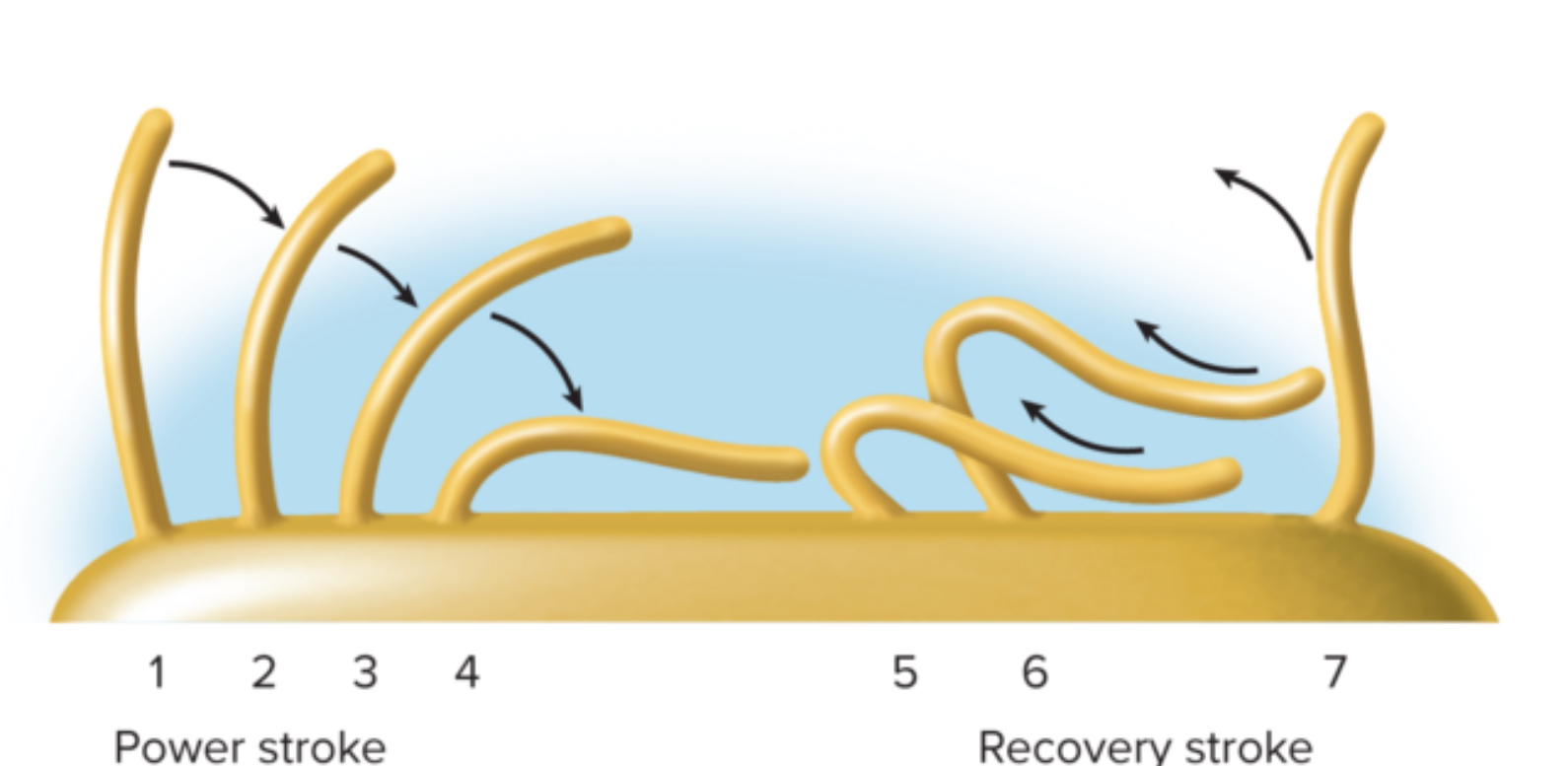
Cystic Fibrosis
lack of cilia in apical membranes, so respiratory tract lots of sticky mucus, clogs it up, in pancreas it clogs up ducts so nutrition so digestion nutrition and respiration are compromised. life expectancy 44 yrs.
Axoneme
structural basis from for ciliary movement, consisting of microtubules, two central tubules and nine microtubule pairs (9+2 structure)
Basal Body
anchors the cilium
Dynein Arms
resides in each pair of peripheral microtubules, makes the cilia move, using ATP to crawl up adjacent microtubles, bending cilia forward.
Flagella
Only one functioning one in human body: Sperm. they are longer than cilium and has a identical axoneme. movement is whiplike
Pseudopods
-cytoplasm filled extensions of the cell
change continually
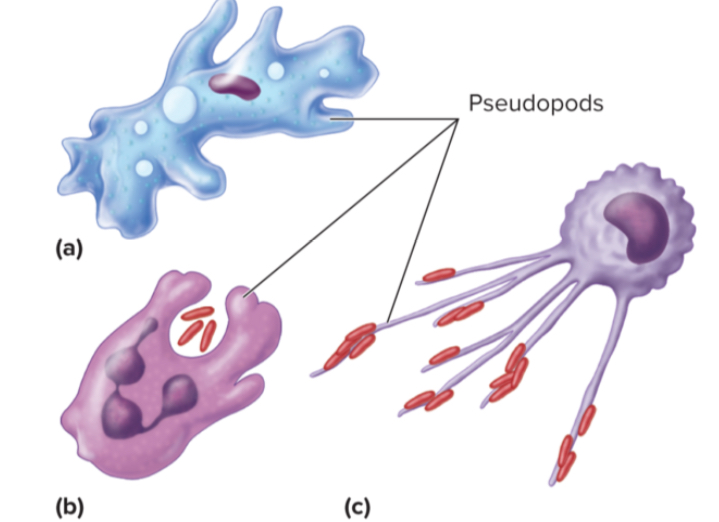
Selectively Permeable
Allows some things to cross such as nutrients and wastes
prevents others like proteins and phosphates from entering or leaving.
Carrier-Mediated Transport
a method of transportation where ATP is needed, active transport, facilitated diffusion, and vesicular are types of this
Passive diffusion
passive mechanisms no ATP is required; filtration, simple diffusion, and osmosis are types of this
Filtration
a process in which physical pressure that forces fluid through a selectively permeable membrane.
An example is a coffee filter, where it holds back larger particles
Blood capillaries are the most important case of filtration bc of blood pressure forces fluid through gaps, it is how water, salts, nutrients and other solutes are transferred from the bloodstream to the tissue fluid and how the kidney filters wastes from blood.
Simple Diffusion
is the net movement of particles from a place of higher concentration to a place of lower concentration
as the result of their constant spontaneous motion.
Concentration gradient
when the concentration of a substance differs from one point to another- up=against gradient, down=with gradient
Why are diffusion rates important for cell survival
They determine how quickly a cell can acquire nutrients or rid itself of wastes.
Factors that affect the rate of diffusion
Temperature (the hotter the faster)
Molecular weight (the heavier the slower)
Steepness of concentration gradient (the greater the concentration the more rapid the diffusion)
Surface Area (the more surface area the faster the diffusion)
Membrane permeability (the more permeable the easier the diffusion)
Osmosis
the net flow of water from one side of permeable membrane to the other.
Crucial for the body’s water distribution
Imbalances underlie problems such as diarrhea, constipation, hypertension and tissue swelling.
The rate and direction of osmosis depend on the
Relative concentration of non-permeating solutes on the two sides of the membrane
Aquaporins
channels of transmembrane proteins through which water diffuses easily.
the more aquaporins the more water can be transported.
In red blood cell amount of water passing through a membrane every 1 sec=100times the volume of the cell.
Osmotic Pressure
The amount of pressure that would have to be applied to one side of a selectively permeable membrane to stop osmosis
Reverse Osmosis
process where mechanical pressure applied to one side of the system can override osmotic pressure and drive water through a membrane against its concentration gradient.
Osmolality
the number of osmoles of a solute per kilogram of water
osmolarity
number of osmoles per liter of solution
1 osmole= 1 mole of dissolved articles
Tonicity
the ability of a solution to affect the fluid volume and pressure in a cell
Osmolarity does not = tonicity
cell placed in solution of
300 miliosm/L of urea (urea penetrates cell easily)
Hypotonic
solution has a lower concentration of nonpermeating solutes than the intracellular fluid.
Causes cells to lose water and shrivel
inside cell
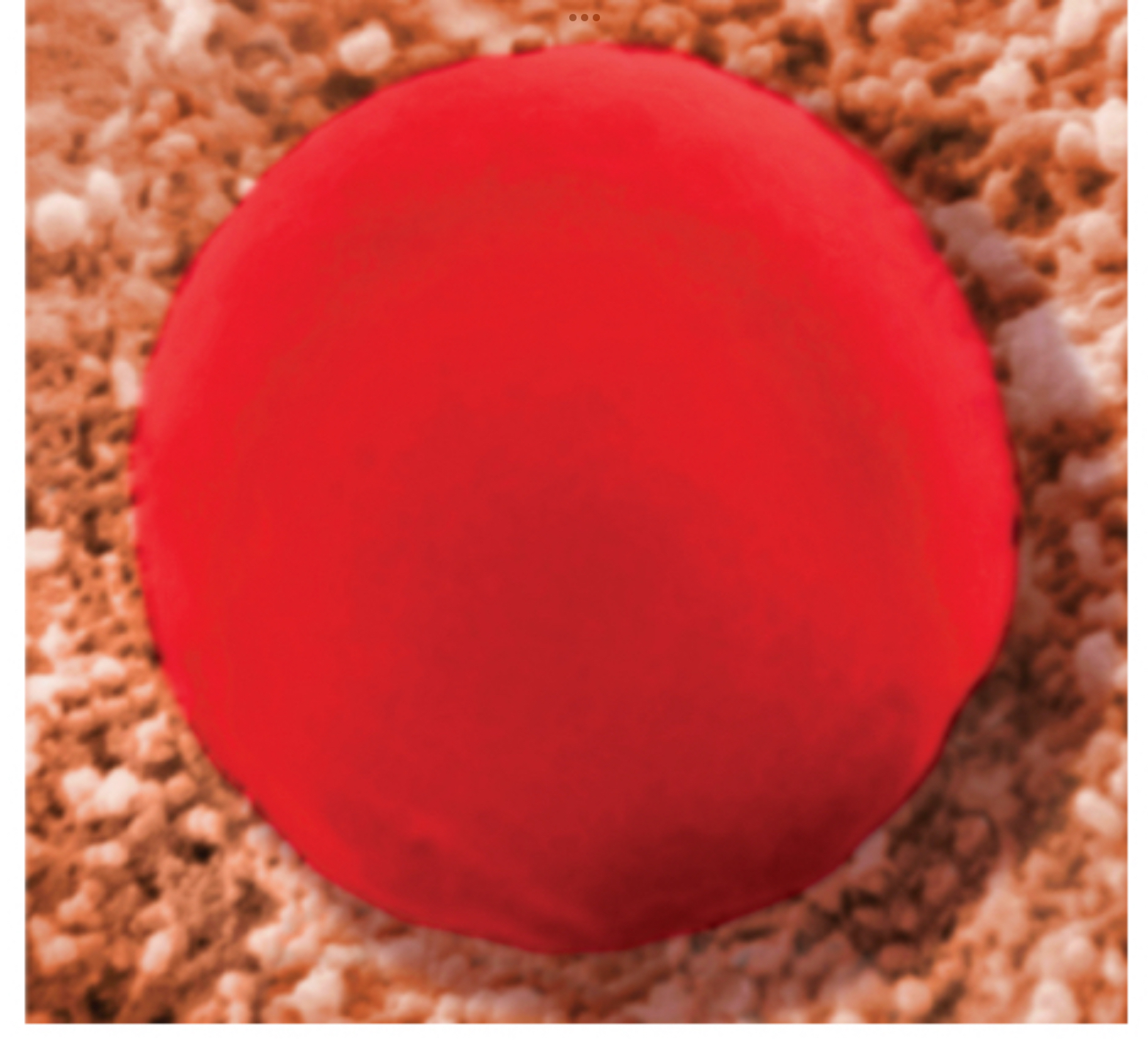
Isotonic
Iso=equal. A solution where the total concentration of a nonpermeating solutes is the same as in the ICF

Hypertonic
a solution with a higher concentration of nonpermeating solutes than the ICF.
Outside cell
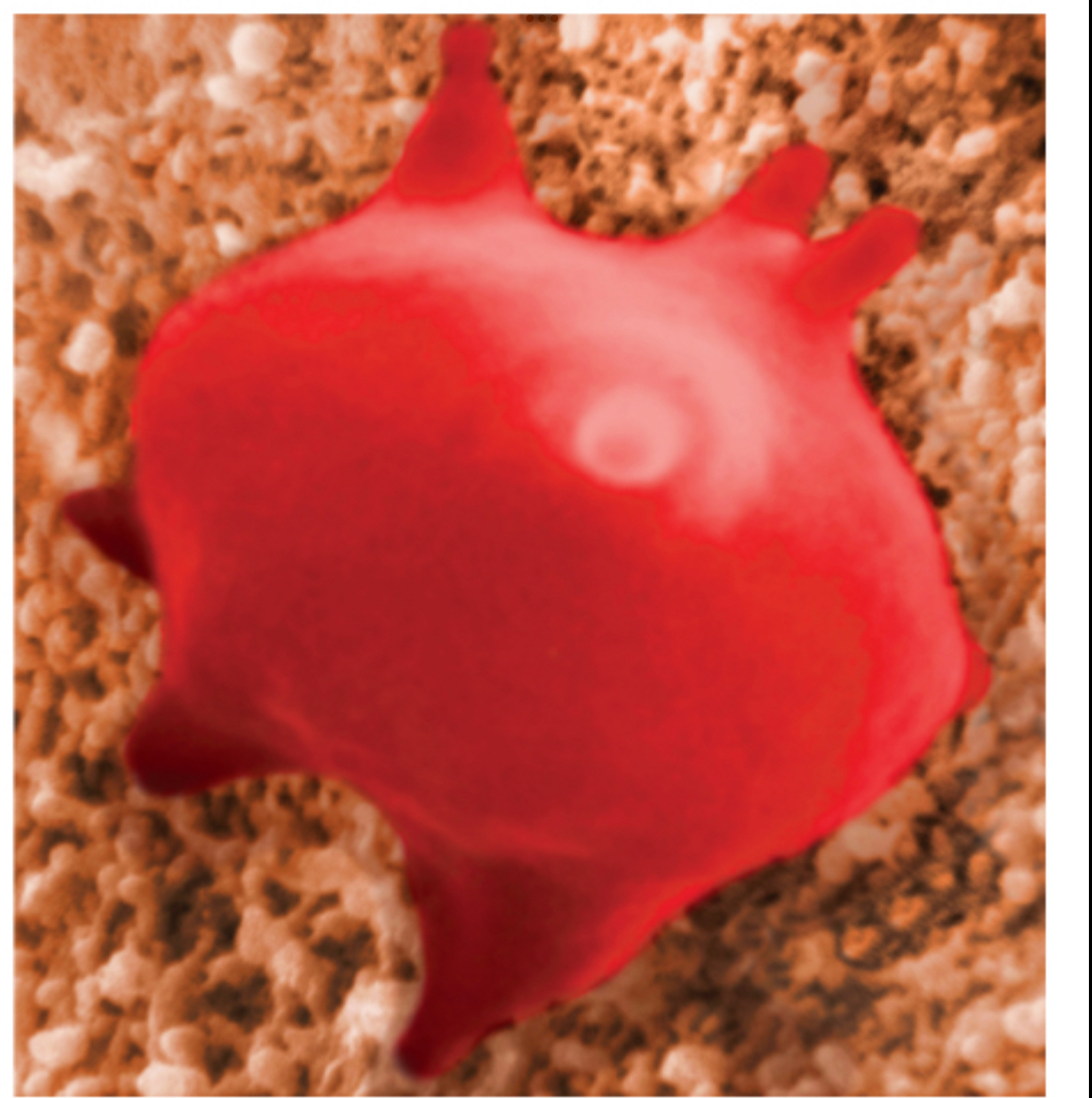
Carrier mediated transport
a solute binds to a carrier in the plasma membrane which then changes shape and releases the solute to the other side.
The process is rapid, one carrier can transport 1000 glucose molecules per second
Transport maximum
When the carriers are saturated and no more are available to handle the increased demand.
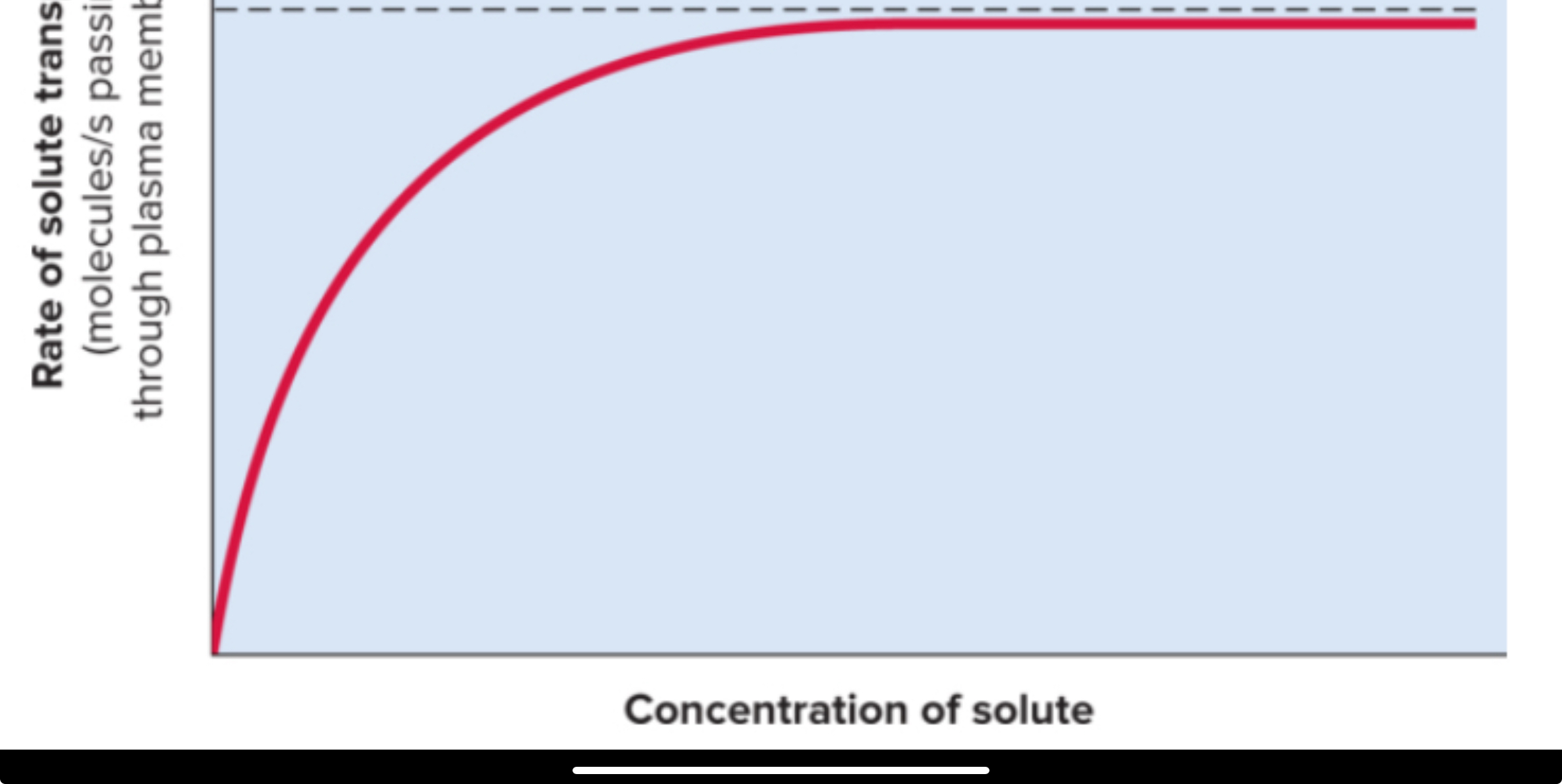
Uniport Carrier
carries one type of solute at a time maintains a low intracellular concentration.
Cotransport
Process moves two or more solutes through a membrane simultaneously in the same direction.
Symport Carrier
Carrier protein that performs cotransport
Ex: the cells in the small intestines and kidneys have a symptom that takes up sodium and glucose simultaneously.
Countertransport
process carrying solutes in opposite directions (the carrier is antiport)
Antiport
Performs countertransport. carries two or more solutes in oppposite directions.
Facilitated Diffusion
Carrier mediated transport of a solute through a membrane down its concentration gradient.
requires no expenditure of ATP
Primary Active Transport
process in which a carrier moves a substance through a cell up its concentration gradient
Uses energy provided by ATP
Secondary Active Transport
requires energy output but depends only indirectly on ATP

Sodium-Potassium Pump (4 functions)
Basal part of cell, constantly removes Na from cell
3 Na out of cell, 2 K in the cell keeps potential (-70mv) across membrane.
1. Regulation of cell volume- anion (proteins and phosphates) attract and retain cations retntion of these would cause swelling. so cellular swelling increase Na Ka ATP pump, feedback loop reduces intracellular ion concentration, controls osmolarity, and prevents cellular swelling.
2. Secondary Active Transport maintains steep Na concentration gradient across the membrane
3. Heat Production-Thyroid stimulates synthesis of Na K Pumps consuming ATP releases heat.
4. Maintenance of a membrane potential- resting membrane potential, inside negative outside positive.
